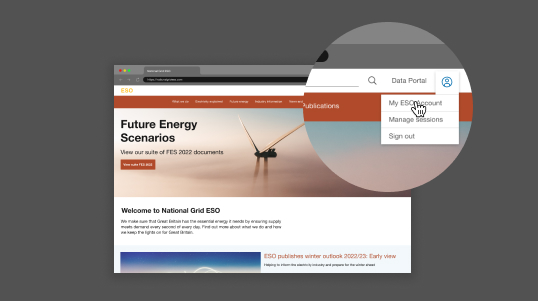The NOA Constraint Management Pathfinder looks for ways to reduce the cost of managing constraints at various places in the electricity system.
The Future Energy Scenarios (FES) and Electricity Ten Year Statement(ETYS) have shown that changes in the volume and location of electricity generation will lead to significant constraint costs if nothing is done.
Reducing the need for build solutions
Reducing the cost of managing constraints means we can mitigate the consequences of unplanned events (post-fault constraint management services), which could help reduce the need for build solutions.
Seeking services from new providers
Constraint service providers are vital to meeting system needs. We’re looking for new providers to help us reduce constraint costs on the electricity system.
We’ll invite potential providers and relevant network owners to submit proposals that address specific system needs. This is a collaborative process between providers, National Grid ESO and the relevant network operators, assessing the proposal’s feasibility and commercial value.
Following technical and economic assessment we will recommend solutions to move forward either via commercial contracts or regulated arrangements.
Our high-level approach to the NOA Constraint Management Pathfinder
Step 1
On 13 May 2020 we held a stakeholder engagement webinar to discuss how we can set out our requirements and recommendations so they’re easy to understand. Webinar slides are available here along with FAQs (updated 5 June), which will be updated from time to time.
Step 2
In December 2019 we launched an RFI on constraint management.
Step 3
In September 2020, we announced our decision to tender for a constraint management service.
Step 4
Following our announcement on the decision to tender at the end of Q2 2020 we are publishing the information about the post fault generation turn down / demand turn up service below. We have included an overview of the service, requirements and a timeline to provide more information on the service.
Step 5
Design and run and tender in FY 2021/22.
Key Documents
As the Electricity System Operator, we must always ensure a stable grid so that energy is delivered safely and reliably to consumers.
Growth in electricity generated from renewable sources results in an increasing need to manage network constraints. In February 2021 we launched our Constraint Management 5 Point Plan, which included a commitment to work with an external consultant to understand the role of storage in managing constraints.
We invited consultants to send us evidence of their capability to do the work and in parallel we invited industry stakeholders to comment on the Draft Scope of Work. The feedback we received was incorporated into the Final Scope of Work and a shortlist of preferred bidders were invited to submit proposals. We selected DNV Services UK Ltd to perform the technical analysis and we worked with them from August to December 2021.
This analysis is now complete, and the key messages of the conclusions we reached are listed below. For more detail on the conclusions we reached, you can read our Storage for Constraints thought piece and for more detail on the analysis DNV performed you can read the Storage for Constraints summary report.
1. In a net zero world, the electricity system looks very different to the one which we have today.
The Government’s target of net zero by 2050 is driving the biggest change in energy technologies since the industrial revolution. The electricity network we have today was built for a centralised system with a generation mix predominantly made up of large, dispatchable, synchronous generation. Tomorrow’s energy system will see increasing amounts of transmission connected renewable generation, changing consumer behaviour patterns, and more decentralised, embedded generation. We need smarter, flexible technologies to help manage the inherent variability we get from renewable generation connected to the transmission system.
2. Energy storage is an essential part of the electricity system transition to net zero.
Our Future Energy Scenarios indicate that significant volumes of energy storage will be required to efficiently manage growing variability in electricity generation and demand, as we decarbonise the energy system. We see storage as a technology that can provide the electricity system with a range of different zero carbon services.
Storage is already the main technology used to provide the grid with very fast frequency response services, and we expect this role to continue to grow. Some storage technologies can also provide other balancing services such as helping manage voltage and inertia. As renewable generation continues to displace traditional dispatchable generation, we see storage playing a role in shifting electricity from when it is generated to when there is the demand for it. As electrification of heat grows, winter electricity demand will increase, creating a new role for inter-seasonal storage which can store larger amounts of electricity for longer periods of time.
3. Whilst storage has value in other markets, our analysis indicates that using storage exclusively for constraint management would be uneconomic.
Operating energy storage exclusively for constraint management leads to low utilisation because for most of the time, the storage is in the wrong state of charge1 or the wrong location to alleviate the constraint. This low utilisation would make it very difficult for current storage technologies to recover their costs and be a more economic option for consumers than other constraint management solutions.
4. Combining constraint management with other services is possible, which would improve the economics, but it may be difficult
Most of the transmission system services that storage can provide can be combined with constraint management services. This indicates that the utilisation of storage providing constraint management could be improved. However, many balancing services cannot be usefully delivered from behind an active export constraint, which may limit the utilisation of storage at the most constrained locations.
5. In the long term, additional transmission infrastructure is the best way to minimise constraint costs. Until then, we are continuing to explore other ways to reduce constraint costs for consumers.
The best way to realise the full benefits of renewable energy generation and to reduce network constraints is to rapidly build additional transmission infrastructure, alongside new technologies and commercial solutions, so that the energy generated can be transported to where it is needed. However, we understand that new network infrastructure isn’t something that can be built overnight, so in the short to medium term we are continuing to work with stakeholders to identify new and innovative ways to reduce network constraints and minimise costs to consumers. Our 5-Point-Plan sets out some of the other options we are looking at to manage constraints.
If you have any further queries about the project, you can contact us at [email protected]
Useful links
The EC5 Constraint Management Intertrip Service (CMIS) aims to reduce network congestion costs in the East Anglian (EC5) region by building post-fault intertrip links between generation across the East Anglia region and the East Anglia Operational Tripping Scheme (EAOTS). By doing so, the ENCC can facilitate more power to flow on the existing transmission infrastructure pre-fault, thus reducing the amount of generation being curtailed pre-emptively when the expected flow exceeds the current capability of the circuits.
The ESO will be launching a market-wide tender in late 2023, that will aim to contract for a EC5 CMIS service to begin in 2025.
The project team are currently in the design phase of the tender and have identified that there is a value opportunity to begin the service early (i.e. set up ‘interim’ contracts).
EC5 CMIS interim consultation and CMIS webinar feedback
EC5 CMIS interim documents
EC5 CMIS interim tender documents
EC5 CMIS interim - tender outcome
CMIS EC5-Enduring documents
CMIS EC5-Enduring expression of interest documents
| Name | Published Sort ascending |
|---|---|
| 1. CMIS EC5-Enduring - EOI letter | 22 Jan 2024 |
| 3. CMIS EC5-Enduring - EOI service terms | 22 Jan 2024 |
| 5. CMIS EC5-Enduring - framework agreement | 22 Jan 2024 |
| 7. EC5-Enduring SCTs v20 against v16 (consultation) | 22 Jan 2024 |
| 2. CMIS EC5-Enduring - EOI submission proforma | 22 Jan 2024 |
| 4. CMIS EC5-Enduring - EOI presentation | 22 Jan 2024 |
| 6. CMIS EC5-Enduring - service specification | 22 Jan 2024 |
One of the key areas of congestion currently on the system is the Anglo-Scottish boundary (B6) which is limited by a constraint, and therefore sometimes requires renewable generation to be turned down pre-fault.
During times of network congestion, we take action to reduce generation pre-fault which can lead to higher constraint costs even though the likelihood of a network fault is very low.
We are aiming to reduce the impact of network constraints, maximise renewable generation on the system and lower costs for the end consumer.
The B6 Constraint Management Pathfinder (CMP) 2024-25 Tender has concluded
Contracts have been successfully awarded to 15 generators for the B6 CMP 2024-25 service delivery, the results of the tender can be viewed below.
Following a consultation on documents relating to the B6 Constraint Management Pathfinder (CMP) 2024-25 service, an Expression of Interest was launched. Successful EOI submissions were assessed for feasibility by the relevant Transmission Owners, and technically feasible parties then had the opportunity to participate within the tender period. They were then assessed against the criteria set out in the Service Specification, and contracts were subsequently awarded to the successful parties.
B6 CMP 2024-25
The documents below are for the current B6 CMP for service delivery September 2024 - October 2025.
These are the results from the B6 CMP 2024-25 tender process.
Any queries please email: [email protected]
B6 CMP 2024-25 Invitation to Tender Documents
The Tender Period was open from Monday 8 August 2022 until Friday 16 September 2022.
The Tender Documents were released on Monday 8 August 2022.
Any queries please email: [email protected]
B6 CMP 2024-25 Expression of Interest Documents
The Expression of Interest stage was open from Monday 28 March until Friday 22 April 2022.
Any queries please email: [email protected]
FAQs published 28 March 2022.
B6 CMP 2024-25 Consultation Documents
These documents were consulted on from 7 February 2022 until 25 February 2022.
Archive CMP B6 2023-24
The documents below are from the last year's CMP B6 tender 2023-24. These are uploaded for reference and are not part of this year's B6 CMP 2024-25 service.
CMP B6 2023-24 Results
These are the results of the B6 CMP 2023-24.
CMP B6 2023-24 Commercial Documents
CMP B6 2023-24 Contract Documents
CMP B6 2023-24 Expression of Interest Documents
Want to stay updated?
If you need to get in touch or need further information drop us an email.
Sign up for our newsletter and tick ‘Network Options Assessment’ to get alerts about new requirements.



